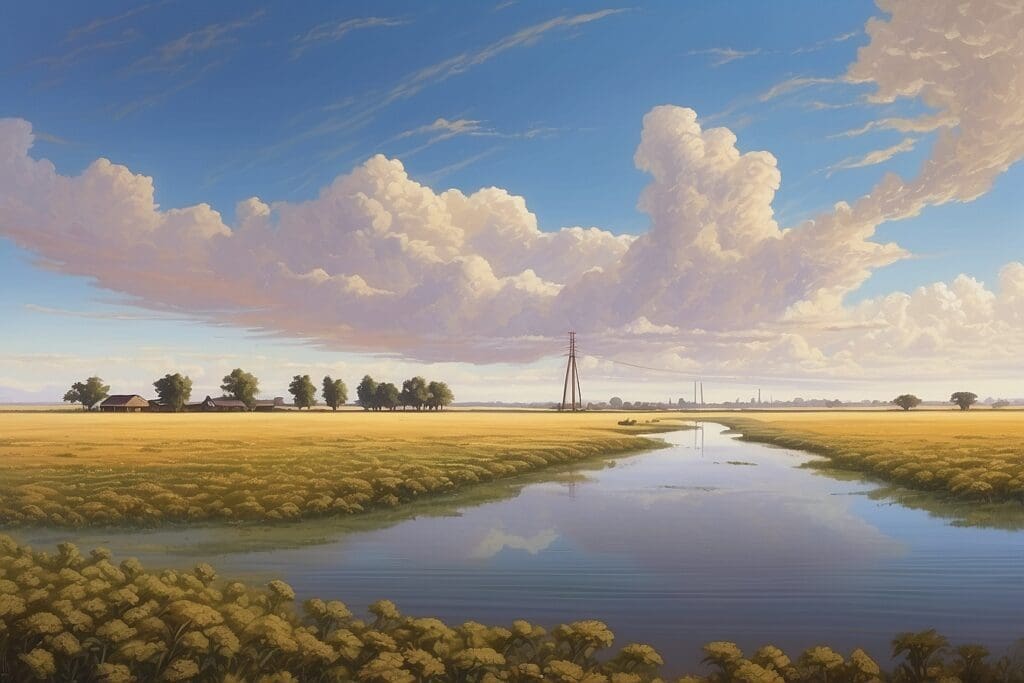Seven thousand years ago, at the confluence of the Sacramento and San Joaquin Rivers in central California, a delta was born. The Sacramento-San Joaquin Delta now consists of a network of waterways that extends for 700 miles. Built up around 57 islands, 1,100 miles of levees, and hundreds of thousands of acres of marshes and mudflats, the Delta provides valuable agricultural land, habitat for over 500 species of plants and animals, and fresh drinking water for over 23 million Californians.1 Unfortunately, the future of this precious resource is in jeopardy.
Delta Reclamation

The rush for California gold in the mid 1800s didn’t just bring miners to the state. Farmers settling in the Delta during this period constructed levees to protect their crops and homes from flooding. The freshwater tidal marshes that dominated the Delta landscape were “reclaimed.” By 1930, farmers had built more than 1700 km of levees and converted nearly all of the marshes in the area into islands for growing crops.3 The problem with trying to farm tule marshes is that, as their name implies, marshes are marshy. Farming of the Delta islands requires extensive drainage ditches to lower water tables below crop root zones. Over time, the constant draining of the tule marsh soils has led to island subsidence. Wind erosion and compaction behind the levees added to the problem and led to further island sinking.
In addition to drainage and erosion, the oxidation of organic or peat deposits actually contributed the most to subsidence. Under natural waterlogged conditions, the Delta soil was anaerobic (poor in oxygen), allowing organic carbon to accumulate faster than it could decompose. But when early Delta settlers drained the land in order to farm it, they exposed the soil to oxygen. This drainage led to aerobic (oxygen rich) conditions. In an aerobic setting, oxygen-rich peat soil decomposes and releases carbon dioxide. The loss of carbon results in the subsidence of land.5 In fact, almost the entire Delta is now at or below sea-level, and the problem is only getting worse.
A Preview of Things to Come?
In June 2004, a levee failed in the Upper Jones Tract of the Delta, flooding about 4,000 acres of land.8 Unfortunately the 2004 levee failure was not an isolated incident. There have been about 35 failures in the Delta since the 1930s, and many of these levee failures have required costly repairs.9 The infrastructure in the Delta is now approximately 100 years old, and the risk of levee failure has increased substantially over the last 50 years. In 1972 a levee failure flooded the city of Isleton, which required $91 million in repairs. In 1980 and 1982 five different tract levees failed, requiring over $48 million in repairs when combined. Finally, in 1986, when several levees failed during the Central Valley flood, a subventions program was started to dedicate local and state funds to levee maintenance.10 Although the 1980s program has increased the funds to improve the condition of the levees, the levees continue to undergo increasing stress—subsidence decreases levee integrity by reducing support and resistance and increasing deformation of peat layers beneath—and are unlikely to withstand a major flood event. 11;12
Not only is the 100-year old infrastructure in the Delta deteriorating, earthquakes and sea level in the Bay Area will rise 28-39 inches by 2100, further compromising the Delta’s fragile levees by putting more pressure on them, and you have a recipe for disaster.15
Risks to Fresh Water
Delta levee failures are of special concern because of their importance in the overall California drinking water infrastructure. The Sacramento-San Joaquin Delta receives runoff from 40% of the land area of California (about 50% of California’s total stream flow), making it the center of California’s massive north-to-south water-delivery system. State and Federal contracts permit the export of up to 7.5 million acre-feet per year from two pumping stations in the Delta. These pumping stations ultimately serve a full two-thirds of California’s population. About 23 million people get at least part of their drinking water from the Delta.16 The acceptability of the water quality from the Delta is dependent on the levee structure. The presence of the western Delta islands is believed to inhibit salinity migration inland from the San Francisco Bay and Delta. If these islands become flooded with saline water, the water available to the pumping facilities that supply water to the rest of the State might become too saline to use.
Given the dire consequences of levee failure, the State of California is scrambling to create a plan. As California Governor Jerry Brown recently put it, “California must implement a science-based plan to ensure safe and adequate water supplies while addressing the severe challenges facing the Delta.”17 In order to truly address the problem of Delta instability, environmental and state planning leaders18 are suggesting that Californians:
- Reduce their reliance on water supplies from the Delta through conservation programs;
- Invest in improvements to Delta levees in the near-term to protect residents while a long-term strategy is developed;
- Develop a long-term plan that includes a canal, pipeline, or tunnel that reduces the vulnerability of the fresh water Delta ecosystem to salinity and aims to restore the Delta ecosystem.19
Unfortunately, Delta island subsidence due to organic material oxidation can only be resolved by major changes in land-use practices. California’s response to the challenges posed by the failing Delta levee system will require tradeoffs and foresight. For more on conserving water, check out this Greeniacs article!





